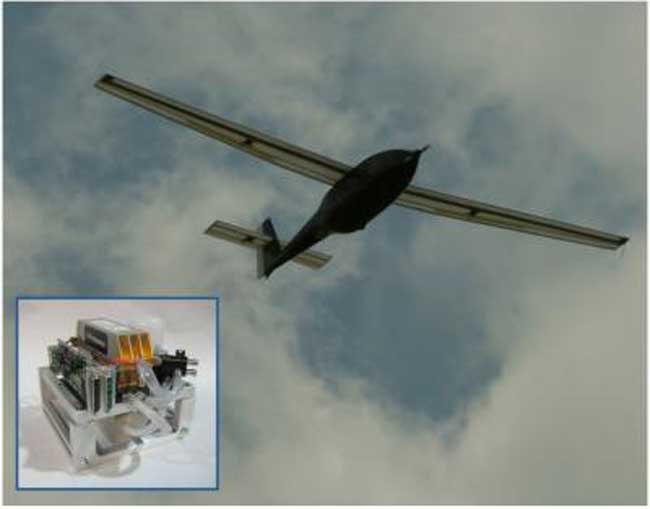Robotic Spy Planes Go Green

Robot spy planes are harnessing alternative energy to make them more covert and longer lasting than ever.
Such drones could also find use in civilian life to help monitor the earth or wildlife as well, researchers noted.
Increasingly, the military is deploying unmanned aerial vehicles, or UAVs, as eyes in the sky to scan the ground for targets and threats, especially for missions that are too dangerous for manned aircraft.
The problem with using internal combustion engines for these spy drones is how noisy they are.
"Think about lawnmowers or chainsaws — they're really loud," said researcher Karen Swider-Lyons, head of the alternative energy section at the Naval Research Laboratory in Washington. "It's hard to spy on people when they know you're there, so you had to fly them at high altitudes to keep them from being heard."
Although researchers sponsored by the Office of Naval Research have developed electrically powered robot spy planes that could fly at low altitudes undetected, "the problem there is that batteries don't have the endurance of internal combustion engines. It's the same issue you see with electric cars."
Now scientists are developing a robot plane that runs off alternative energy. The hydrogen fuel cell that powers the "Ion Tiger" UAV make it travel farther and carry heavier payloads than battery-powered designs, yet are still more stealthy than internal combustion engine designs with its reduced noise, heat and emissions. {{ video="LS_091013_IONTiger" title="Ion Tiger Takes to the Skies" caption="The Ion Tiger has better flight endurance than battery-powered drones." }}
Sign up for the Live Science daily newsletter now
Get the world’s most fascinating discoveries delivered straight to your inbox.
Fuel cells generate an electrical current when they convert hydrogen and oxygen into water. Their emissions are not only pollution-free, but such a propulsion system can potentially also deliver twice the efficiency of an internal combustion engine, while running more quietly and with greater endurance. The 550-watt, 0.75 horsepower hydrogen fuel cell that drives Ion Tiger has about four times the efficiency of a comparable internal combustion engine and seven times the energy in the equivalent weight of batteries.
"With UAVs, we are dealing with relatively small fuel cells of 500 watts," Swider-Lyons explained. "It is hard to get custom, high-quality fuel cell membranes built just for this program. So we are riding along with this push for technology from the automotive industry."
"In this size range, we are hopefully able to conduct very productive surveillance missions at low cost with a relatively small vehicle, and a high-quality electric payload," she added.
When Ion Tiger took flight on October, it exceeded any demonstration of electrically powered flight so far, flying 23 hours and 17 minute straight.
"And it carried a 5 lbs. payload to boot — enough to carry, say, a day-and-night camera," Swider-Lyons said. "No one has come close to flying 24 hours with a significant payload before."
The weather was very rough during the flight, so they spent more fuel than expected. They plan to fly again next month, "and weather permitting, we should get we above 24 hours," Swider-Lyons said.
Swider-Lyons added that fuel cell drones could readily find use in civilian applications as well — perhaps for monitoring the atmosphere, oceans or wildlife. "Our job is just to push on technology and show what is possible," she said. "Remember that the Naval Research Laboratory made GPS happen in the '60s — you know what happened from there."
The benefits seen with Ion Tiger help showcase how alternative energy might help society at large.
"Can you imagine a green city with electric vehicles, quiet and not spewing diesel exhaust everywhere?" Swider-Lyons said. "You'll have people looking back and can't believing that we lived in such noisy cities with such pollution. It's not just an energy issue, but you're looking at quality of life improvements as well."
- 5 Reasons to Fear Robots
- Top 10 Emerging Environmental Technologies
- Video: Your Own Personal Drone

Ancient 'military outpost' in North Macedonia might be birthplace of Alexander the Great's grandmother
NASA rover discovers out-of-place 'Skull' on Mars, and scientists are baffled
A long-lost ice sheet could predict the future of New York City — one in which Lower Manhattan and Coney Island are 'perpetually submerged'









